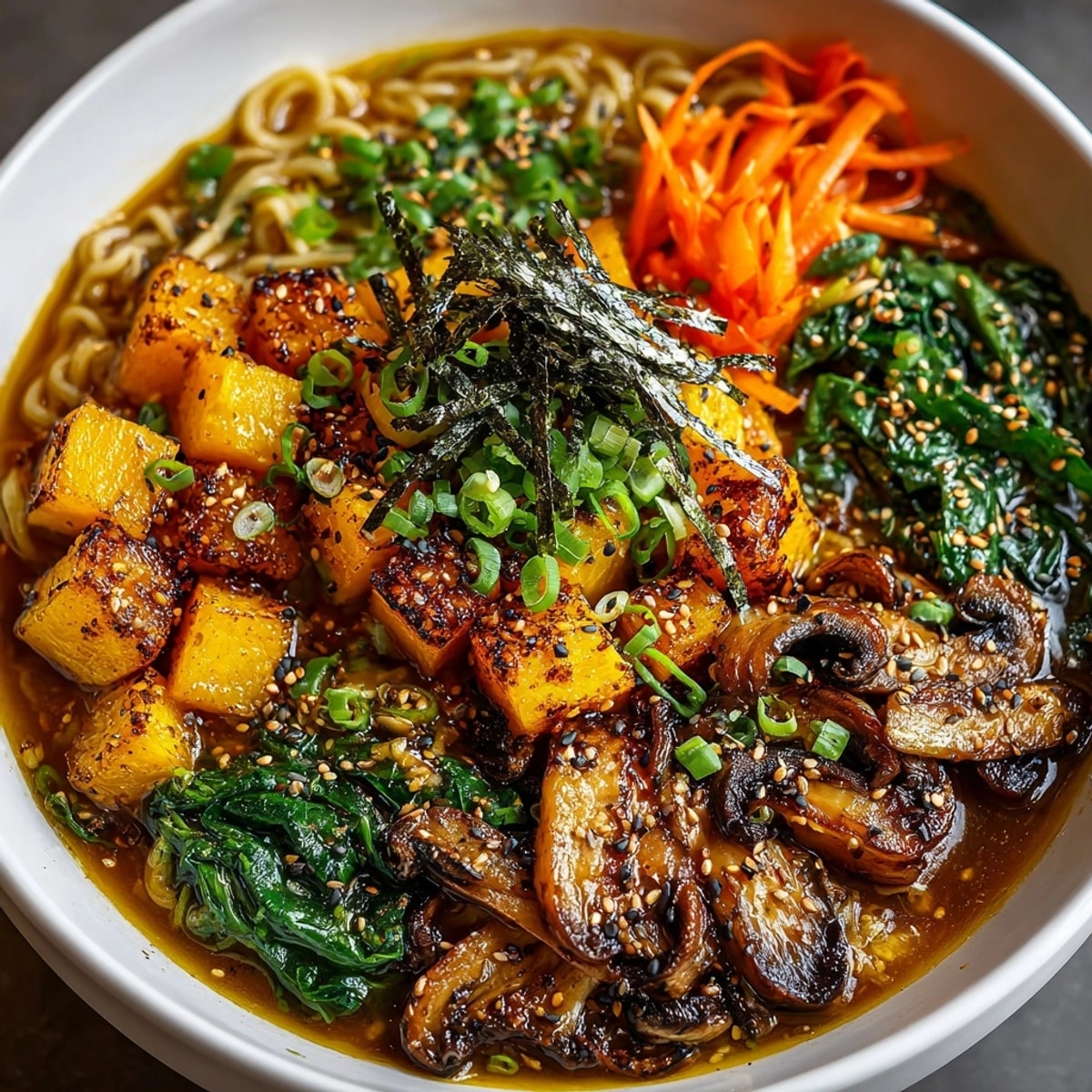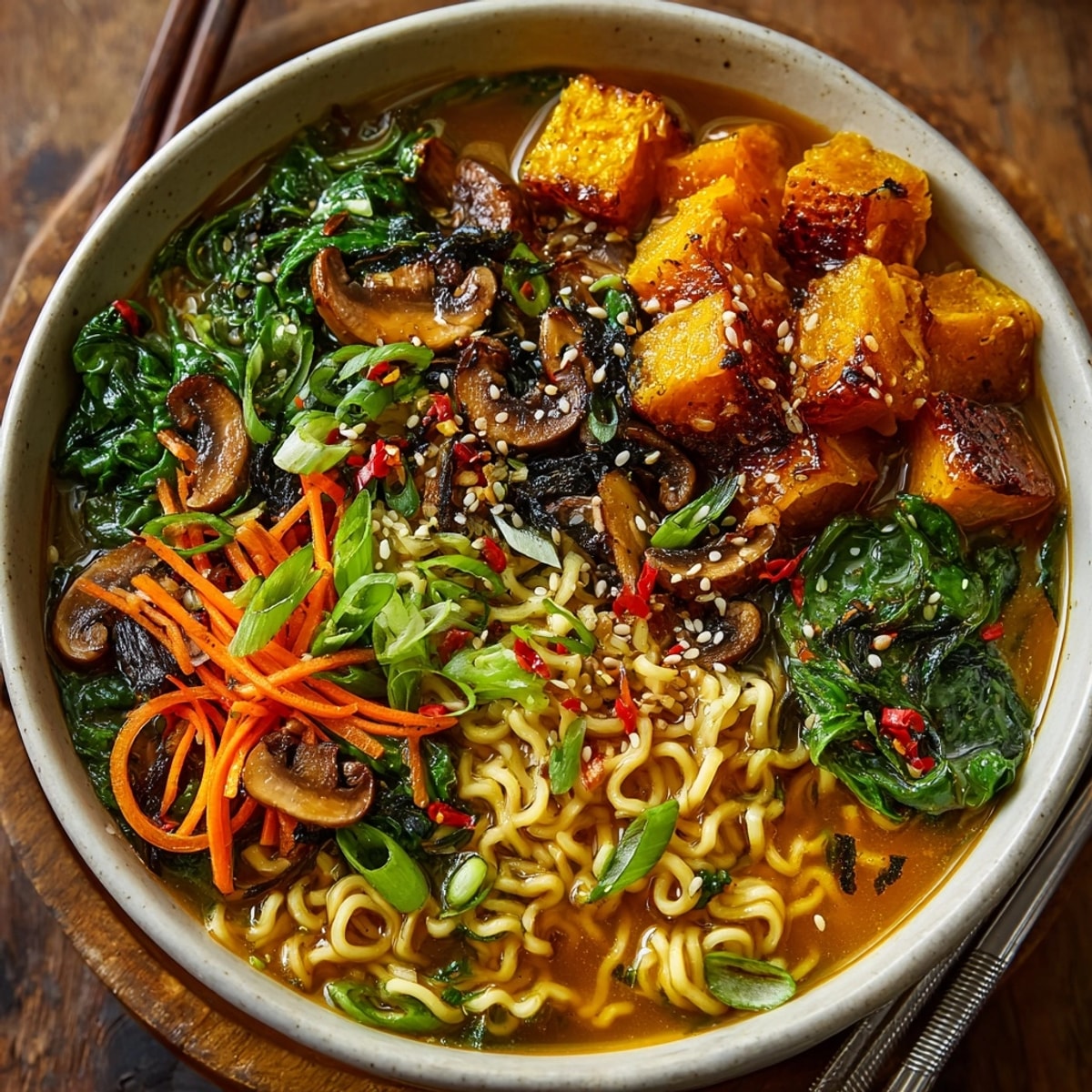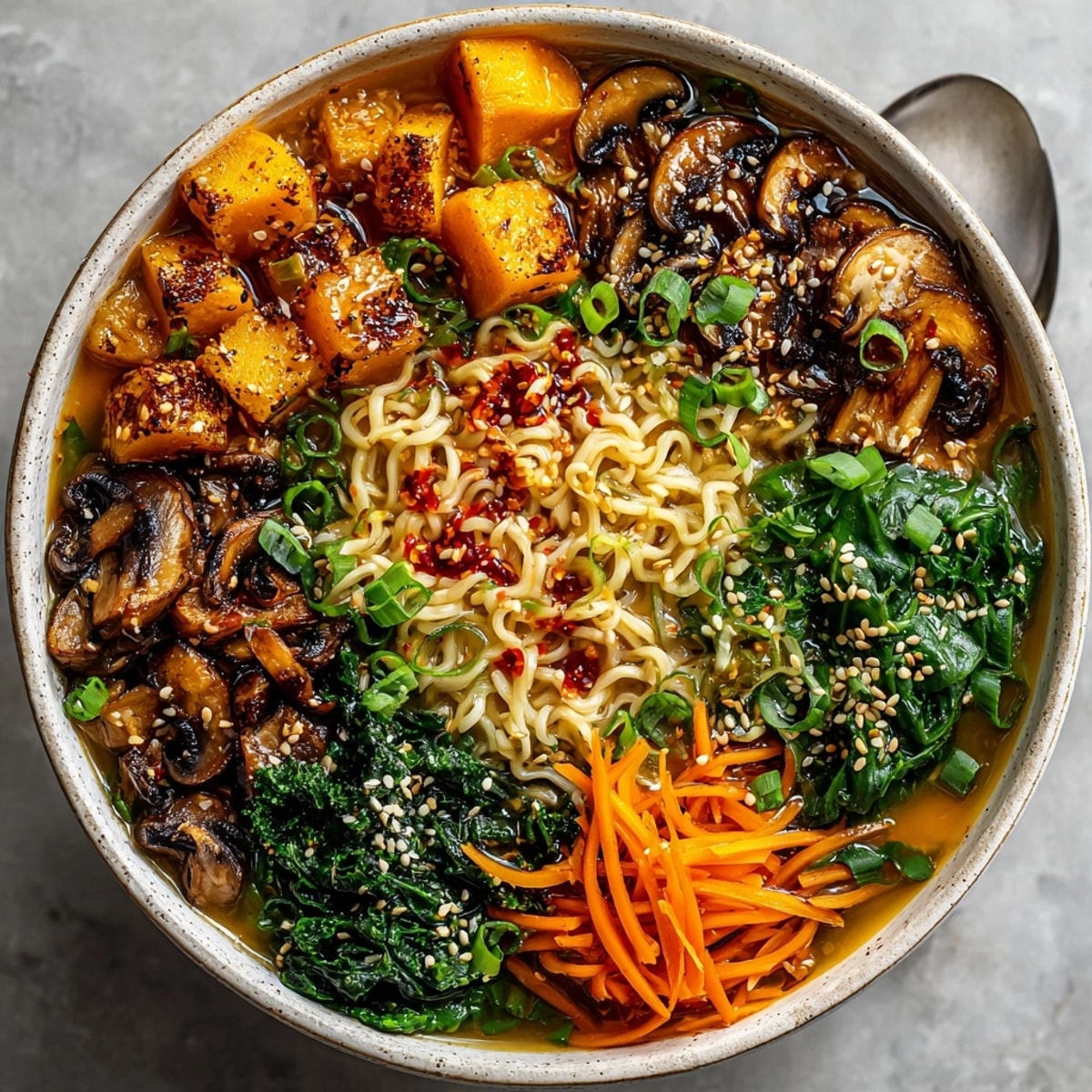 Pin
Pin This Japanese-inspired pumpkin ramen bowl transforms simple ingredients into a soul-warming meal that brings restaurant-quality comfort to your home kitchen. The combination of roasted pumpkin with its caramelized edges and a fragrant ginger broth creates layers of flavor that will transport you straight to a cozy ramen shop on a rainy day.
I first created this recipe during autumn when pumpkins were abundant at my local farmers market. After returning from a trip to Japan, I was craving those deep umami flavors and decided to combine seasonal produce with traditional Japanese techniques. Now it has become our Sunday evening tradition during the colder months.
Ingredients
- Pumpkin: 500g cubes The natural sweetness caramelizes beautifully look for firm sugar or kabocha pumpkin
- Vegetable oil: 2 tbsp Choose a neutral oil with high smoke point
- Soy sauce: 1 tsp Adds umami depth and helps with caramelization
- Ground ginger: 1/2 tsp Warming spice that complements fresh ginger in broth
- Ground coriander: 1/2 tsp Adds citrusy notes that balance the sweetness
- Ground white pepper: 1/2 tsp More delicate than black pepper perfect for this dish
- Salt: 1/2 tsp Enhances all other flavors
- Vegetable oil: 1 tbsp For sautéing aromatics
- Large onion: thinly sliced Creates sweetness as base for broth
- Garlic: 4 cloves minced Essential aromatic that infuses the broth
- Fresh ginger: 2inch piece The star ingredient providing warmth and zing
- White miso paste: 1 tbsp Fermented soybean paste adds complex savory notes
- Soy sauce: 1 tbsp Deepens color and umami flavor
- Mirin: 1 tbsp Sweet rice wine adds subtle sweetness
- Rice vinegar: 1 tbsp Balances with bright acidity
- Vegetable broth: 1.5 liters Use quality broth as it forms the foundation
- Dried kombu strip: optional Seaweed that adds ocean umami notes
- Ramen noodles: 300g Fresh noodles are best if available
- Shiitake mushrooms: 100g sliced Meaty texture and earthy flavor
- Baby spinach: 100g Adds color nutrition and wilts perfectly in hot broth
- Spring onions: thinly sliced For fresh bite and color contrast
- Carrot: julienned Adds crunch and natural sweetness
- Toasted sesame seeds: 1 tbsp Nutty finish that elevates the dish
- Nori sheet: cut into strips Ocean flavor and traditional garnish
- Chili oil or shichimi togarashi: optional For customizable heat
Instructions
- Roast the Pumpkin:
- Preheat your oven to 200°C (400°F). In a large mixing bowl, combine the cubed pumpkin with vegetable oil, ensuring each piece is well-coated. Sprinkle with soy sauce, ground ginger, coriander, white pepper, and salt, then toss thoroughly to distribute the seasonings evenly. The soy sauce will caramelize during roasting, creating beautiful umami notes. Spread the seasoned pumpkin in a single layer on a baking sheet, giving each piece space to roast properly. Roast for 25-30 minutes, turning halfway through, until the edges are golden brown and slightly crisp while the centers remain tender.
- Create the Aromatic Base:
- While the pumpkin roasts, place a large heavy-bottomed pot over medium heat and add the vegetable oil. Once shimmering but not smoking, add the thinly sliced onion. Cook for 2 minutes until beginning to soften, then add the minced garlic and sliced ginger. Sauté for another 2-3 minutes, stirring frequently to prevent burning. You want the aromatics to become fragrant and slightly translucent but not browned, which would create bitter notes in the broth.
- Build the Broth:
- Once your aromatics are fragrant, reduce the heat slightly and add the white miso paste. Use a wooden spoon to break it down and incorporate it into the oil and vegetables. This technique helps the miso distribute evenly without clumping. Add the soy sauce, mirin, and rice vinegar, stirring constantly for about 1 minute. The alcohol in the mirin will cook off while leaving its sweet essence. These ingredients create the tare, or flavor base, that gives your ramen its distinctive character.
- Simmer to Perfection:
- Pour in the vegetable broth and add the kombu strip if using. Bring the mixture to a gentle simmer, then reduce heat to low. Cover partially with a lid and allow to simmer for 20 minutes, during which time all the flavors will meld together. The kombu will slowly release its glutamates, enhancing the umami flavor of the broth. After 20 minutes, remove and discard the kombu and ginger slices if you prefer a cleaner broth. Taste and adjust seasonings as needed.
- Prepare the Noodles:
- While the broth simmers, bring a separate large pot of water to a rolling boil. Cook your ramen noodles according to package instructions, being careful not to overcook them as they will continue to soften in the hot broth. Fresh noodles typically take 1-2 minutes, while dried may need 3-4 minutes. Test for doneness by taking a noodle and biting through it. It should be tender but still have a slight chew. Drain immediately and rinse briefly with cool water to stop the cooking process and remove excess starch.
- Sauté the Mushrooms:
- Heat a small pan over medium-high heat. Add a small amount of oil and when hot, add the sliced shiitake mushrooms. Cook undisturbed for 1-2 minutes to allow them to brown slightly, then stir and continue cooking for another 2 minutes until they release their moisture and become tender. Season with a tiny pinch of salt to enhance their natural umami flavor. Well-cooked shiitakes add a meaty texture and earthy depth to the final dish.
- Assemble the Ramen Bowls:
- Divide the cooked noodles among four deep, warmed serving bowls, arranging them in a neat mound at the center. Ladle the hot ginger broth over the noodles, pouring it around the edges to heat the bowl evenly. The broth should come about three-quarters up the noodles, allowing some to remain above the liquid for textural contrast. Arrange the roasted pumpkin pieces attractively on top, placing them slightly off-center to create visual interest.
- Complete with Toppings:
- Artfully arrange the sautéed shiitake mushrooms, fresh baby spinach (which will wilt naturally in the hot broth), julienned carrots, and sliced spring onions around the bowl. The goal is to create a visually appealing color palette. Sprinkle toasted sesame seeds evenly over the surface and tuck strips of nori partially into the broth, leaving some exposed. Offer chili oil or shichimi togarashi on the side for those who enjoy heat. Serve immediately while piping hot, instructing diners to mix everything together before eating.
 Pin
Pin The fresh ginger is truly the heart of this recipe. I discovered its transformative power while recovering from a cold one winter. The warming heat and aromatic quality it brings to the broth creates a foundation that supports all the other flavors without overpowering them. My family now recognizes the distinctive scent of ginger simmering as a signal that comfort food is on its way.
Make-Ahead Options
This ramen bowl components can be prepared in advance for quick assembly during busy weeknights. The roasted pumpkin will keep in an airtight container for up to 3 days in the refrigerator. The broth actually improves with time as flavors meld, making it perfect to prepare a day ahead. Store it separately from noodles and toppings. When ready to serve, simply reheat the broth until steaming, cook fresh noodles, and assemble with prepared toppings for a restaurant-quality meal in minutes.
Seasonal Adaptations
In summer months when pumpkin is less available, substitute with sweet potato or butternut squash for similar texture and sweetness. During spring, add fresh peas and asparagus tips for brightness. Winter variations benefit from heartier additions like roasted Brussels sprouts or parsnips. Fall is ideal for incorporating chestnuts or kabocha squash. The versatile ginger broth welcomes seasonal produce while maintaining its comforting character throughout the year.
- Lighten summer versions with extra lime juice and fresh herbs
- Add warming spices like star anise in winter versions
- Use seasonal mushroom varieties when available
Cultural Context
Ramen has evolved significantly from its Chinese origins to become one of Japan's most beloved comfort foods. Traditional ramen typically features meat-based broths, but vegetable versions like this one have gained popularity as plant-based eating expands globally. The addition of pumpkin represents a fusion approach, incorporating Western ingredients into an Eastern framework. While not strictly authentic, this recipe honors the Japanese principles of balanced flavors, attention to detail, and respect for ingredients while making the dish accessible for home cooks outside Japan.
Troubleshooting Tips
If your broth lacks depth, try adding a tablespoon of tahini or peanut butter for richness without compromising the vegetarian profile. For too-salty broth, add a splash of water and a squeeze of lemon juice to balance flavors. If noodles become soggy, cook them very al dente initially, or for best results, keep noodles and broth separate until just before serving. The most common mistake is rushing the broth development. Allow proper simmering time for aromatics to fully infuse the liquid.
Serving Suggestions
Present this ramen as the centerpiece of an Asian-inspired meal by adding simple sides like edamame sprinkled with sea salt or quick-pickled cucumbers with rice vinegar and sesame oil. For a more substantial meal, offer crispy vegetable gyoza on the side. Traditional accompaniments include Japanese beer, hot green tea, or for non-alcoholic options, sparkling water with yuzu or cucumber. Serve in deep, warmed bowls with both chopsticks and soup spoons for the full experience.
 Pin
Pin Serve immediately while piping hot, instructing diners to mix everything together before eating.
Recipe Q&A
- → Can I substitute pumpkin with another squash?
Yes, kabocha squash works well, adding a sweeter touch and firm texture to the dish.
- → How do I ensure the broth is flavorful?
Simmer the broth with miso, soy sauce, fresh ginger, and kombu for a rich, umami-packed base.
- → Is this suitable for vegan diets?
Yes, choose egg-free noodles and check toppings to keep the bowl entirely plant-based.
- → What can I add for more protein?
Add tofu or a soft-boiled egg, or use extra mushrooms to boost plant-based protein.
- → Can I make this gluten-free?
Use gluten-free ramen noodles and tamari instead of regular soy sauce for a gluten-free variation.
- → What toppings add extra flavor?
Nori strips, spring onions, toasted sesame, and chili oil or shichimi togarashi elevate the bowl's taste.

